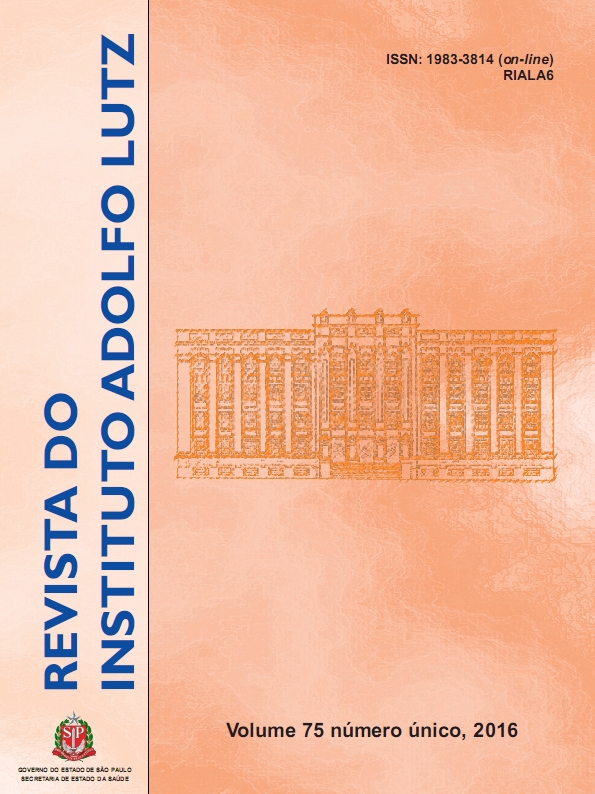Abstract
In São Paulo the mumps virus (MuV) outbreaks have been increasing from 2011 to nowadays. MuV epidemiological surveillance has been improving by using the polymerase chain reaction in real time (rRT-PCR) in addition to the specific IgM antibody (IgM-Ab) detection; in some cases, genome sequencing studies were performed. Increased virus transmission and recent outbreaks have raised interest on MuV genotyping, as a means to understand the transmission pathways and to identify the vaccine-associated cases. From January 2011 to August 2016, MuV infection was analyzed at Institute Adolfo Lutz. A total of 232 (77.33 %) throat wash samples showed positivity to mumps genome, and 68 (22.66 %) were negative when analyzed by rRT-PCR. Among 15 samples for molecular analysis, 10 serum samples from respective patients were also available for detecting anti-MuV IgM-Ab; and from these, four (40%) samples were seropositive. Vaccination status was available only for patients from Cedral and Araraquara. Phylogenetic analysis revealed the circulation of the following mumps virus genotypes in the investigated periods: 2011(M), 2012, and 2013 (K); 2014 (N); 2015 (G, K, and N); 2016 (G). Knowledge on MuV molecular epidemiology in São Paulo-Brazil could contribute to the surveillance and epidemiological program in Brazil, and globally as well.
References
1. WHO. Mumps virus nomenclature update: 2012. Wkly Epidemiol Rec. 2012;87 (22):217–24.
2. Hviid A, Rubin S, Mühlemann K. Mumps. Lancet. 2008;371:932-44. [DOI:10.1016/S0140-6736(08)60419-5].
3. Albertson JP, Clegg WJ, Reid HD, Arbise BS, Pryde J, Vaid A, et al. Mumps Outbreak at a University and Recommendation for a Third Dose of Measles-Mumps-Rubella Vaccine — Illinois, 2015–2016. MMWR Morb.Mortal.Wkly Rep. 2016;65(29):731–34. [DOI:10.15585/mmwr.mm6529a2].
4. Kutty PK, McLean HQ, Lawler J, Schulte C, Hudson JM, Blog D, et al. Risk factors for transmission of mumps in a highly vaccinated population in Orange County, NY, 2009-2010. Pediatr Infect Dis J. 2014;33(2):121-5. [DOI: 10.1097/INF.0000000000000020].
5. Park SH. Resurgence of mumps in Korea. Infect Chemother. 2015;47(1):1-11. [DOI:10.3947/ic.2015.47.1.1].
6. Jin L, Örvell C, Myers R, Rota PA, Nakayama T, Forcic D, et al. Genomic diversity of mumps virus and global distribution of the 12 genotypes. Rev Med Virol. 2015;25:85-101. [DOI:10.1002/rmv.1819].
7. Jin L, Brown DW, Litton PA, White JM. Genetic diversity of mumps virus in oral fluid specimens: application to mumps epidemiological study. J Infect Dis. 2004;189 (6):1001–8. [DOI:10.1086/382134].
8. Jin L, Vyse A, Brown DW. The role of RTPCR assay of oral fluid for diagnosis and surveillance of measles, mumps and rubella. Bull World Health Organ. 2002;80(1):76 –7.
9. Boddicker JD, Rota PA, Kreman T, Wangeman A, Lowe L, Hummel KB, et al. Real – time reverse transcription – PCR assay for detection of mumps virus RNA in clinical specimens. J Clin Microbiol. 2007;45(9): 2902–8. [DOI:10.1128/JCM.00614-07].
10. Echevarría JE, Castellanos A, Sanz JC, Martinez de Aragón MV, Peña Rey I, Mosquera M, et al. Mumps vírus genotyping: Basis and Known circulating genotypes. Open Vaccine J. 2010;3:37–41.

This work is licensed under a Creative Commons Attribution 4.0 International License.
Copyright (c) 2016 Instituto Adolfo Lutz Journal
